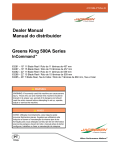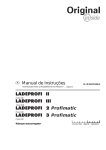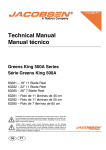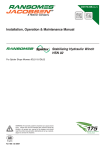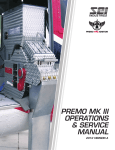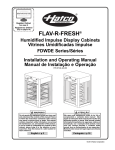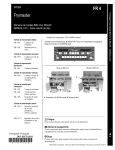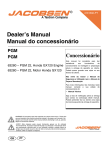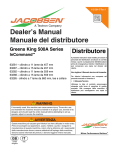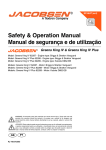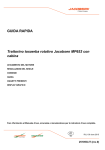Download Dealer`s Manual Manual do concessionário
Transcript
4131584-PT-Rev A Dealer’s Manual Manual do concessionário Greens King 500A Series Distribuidor InCommand™ 63281 – Rolo de 11 lâminas de 457 mm 63287 – Rolo de 15 lâminas de 457 mm 63282 – Rolo de 11 lâminas de 559 mm 63288 – Rolo de 15 lâminas de 559 mm 63285 – Rolo de 7 lâminas de 660 mm, Tee e Colar Este manual destina-se a ajudar o pessoal comercial na instalação adequada e preparação do equipamento antes da entrega ao cliente. Pode desejar manter um exemplar na sua ficha de cliente. Não remover o manual técnico do cortarelva. Para obter informação adicional não incluída neste manual, consulte o exemplar do seu escritório de: • O Manual técnico Use a lista de verificações antes da entrega existente no interior da contracapa deste manual. Pode desejar entregar um exemplar ao cliente aquando da entrega da unidade. WARNING If incorrectly used, this machine can cause severe injury. Those who use and maintain this machine should be trained in its proper use, warned of its dangers and should read the entire manual before attempting to set up, operate, adjust or service the machine ATENÇÃO Esta máquina pode causar ferimentos graves se for utilizada incorrectamente. A pessoa responsável pela sua utilização e manutenção deve ser previamente instruída para a sua utilização correcta, avisada sobre os perigos que ela pode causar e deve ler todo o manual antes de tentar preparar, conduzir, afinar ou reparar a máquina. GB PT Portuguese When Performance Matters.™ CONTENTS 1 1 2 2.1 2.2 3 3.1 3.2 4 4.1 4.2 4.3 4.4 CONTENTS CONTENTS SAFETY Operating Safety.................................................. 3 Important Safety Notes ........................................ 4 CONTROLS Icons .................................................................... 5 Controls ............................................................... 5 SET UP General ................................................................ 7 Initial inspection ................................................... 7 operating checks .................................................. 7 Operator Presence Control .................................. 8 5 5.1 5.2 5.3 5.4 5.5 5.6 5.7 6 ADJUSTMENTS General................................................................ 9 Reel To Bedknife ................................................. 9 Bedknife ............................................................. 10 Brake ................................................................. 10 Cutting Height .................................................... 11 Handle ............................................................... 11 Torque Specification .......................................... 12 NOTES Proposition 65 Warning Engine exhaust from this product contains chemicals known to the State of California to cause cancer, birth defects, and other reproductive harm © COPYRIGHT 2005, TEXTRON INC. “All rights reserved, including the right to reproduce this book or portions thereof in any form”. All information in this publication is based on information available at time of approval for printing. Jacobsen reserves the right to make changes at any time without notice and without incurring any obligation. LITHO IN U.S.A 6-2013 2 SAFETY 2 2.1 2 SAFETY OPERATING SAFETY ______________________________________________________ ! WARNING EQUIPMENT OPERATED IMPROPERLY OR BY UNTRAINED PERSONNEL CAN BE DANGEROUS. Familiarize yourself with the location and proper use of all controls. Inexperienced operator’s should receive instruction from someone familiar with the equipment before being allowed to operate the machine. 1. Safety is dependent upon the awareness, concern and prudence of those who operate or service the equipment. Never allow minors to operate any equipment. 2. It is your responsibility to read this manual and all publications associated with this equipment (Engine manual, accessories and attachments). If the operator can not read English it is the owner’s responsibility to explain the material contained in this manual to them. 3. Learn the proper use of the machine, the location and purpose of all the controls and gauges before you operate the equipment. Working with unfamiliar equipment can lead to accidents. 4. Never allow anyone to operate or service the machine or its attachments without proper training and instructions; or while under the influence of alcohol or drugs. 5. Wear all the necessary protective clothing and personal safety devices to protect your head, eyes, ears hands and feet. Operate the machine only in daylight or in good artificial light. 6. 7. Evaluate the terrain to determine what accessories and attachments are needed to properly and safely perform the job. Only use accessories and attachments approved by Jacobsen. Stay alert for holes in the terrain and other hidden hazards. 8. Inspect the area where the equipment will be used. Pick up all the debris you can find before operating. Beware of overhead obstructions (low tree limbs, electrical wires, etc.) and also underground obstacles (sprinklers, pipes, tree roots, etc.) Enter a new area cautiously. Stay alert for hidden hazards. 9. 10. Never direct discharge of material toward bystanders, nor allow anyone near the machine while in operation. The owner/operator can prevent and is responsible for injuries inflicted to themselves, to bystanders and damage to property. 11. Never operate equipment that is not in perfect working order or is without decals, guards, shields, discharge deflectors or other protective devices securely fastened in place. 12. Never disconnect or bypass any switch. 13. Carbon monoxide in the exhaust fumes can be fatal when inhaled. Never operate the engine without proper ventilation. 14. Fuel is highly flammable, handle with care. 15. Keep the engine clean. Allow the engine to cool and always remove the spark plug wire from the spark plug before storing. 16. Place unit on a flat surface, disengage all drives and engage parking brake before starting the engine. 17. Local regulations may restrict the age of the operator. 18. Operate the machine across the face of the slope (horizontally), not up and down the slope (vertically). 19. Always operate at speeds that allow you to have complete control of the machine. Be sure of your footing; keep a firm hold on the handle and walk; never run. 20. Before you clean, adjust or repair this equipment, stop the engine, disconnect the spark plug wire, and keep the wire away from the plug to prevent accidental starting. Do not carry passengers. Keep bystanders and pets a safe distance away. This machine is to be operated and maintained as specified in this manual and is intended for the professional maintenance of specialized turf grasses. It is not intended for use on rough terrain or long grasses. 3 2 2.2 SAFETY IMPORTANT SAFETY NOTES _______________________________________________ ! This safety alert symbol is used to alert you to potential hazards. DANGER - Indicates an imminently hazardous situation which, if not avoided, WILL result in death or serious injury. WARNING - Indicates a potentially hazardous situation which, if not avoided, COULD result in death or serious injury. CAUTION - Indicates a potentially hazardous situation which, if not avoided, MAY result in minor or moderate injury and property damage. It may also be used to alert against unsafe practices. For pictorial clarity, some illustrations in this manual may show shields, guards or plates open or removed. Under no circumstances should this equipment be operated without these devices securely fastened in place ! WARNING The Operator Presence Control (OPC) on this machine will shut off the reel and traction drive if the operator releases the OPC bail. To protect the operator and others from injury, never operate equipment with the OPC system disconnected or malfunctioning. ! WARNING 1. Before leaving the operator’s position for any reason: a. Disengage all drives. b. Engage parking brake. c. Stop engine. 2. Keep hands, feet, and clothing away from moving parts. Wait for all movement to stop before you clean, adjust or service the machine. 3. Keep the area of operation clear of all bystanders and pets. 4. Chock or block the wheels if the machine is left on an incline. 5. Never operate mowing equipment without the discharge deflector securely fastened in place. By following all instructions in this manual, you will prolong the life of your machine and maintain its maximum efficiency. Adjustments and maintenance should always be performed by a qualified technician. If additional information or service is needed, contact your Authorized Jacobsen Dealer who is kept informed of the latest methods to service this equipment and can provide prompt and efficient service. Use of other than original or authorized Jacobsen parts and Accessories will void the warranty. 4 CONTROLS 3 3.1 3 CONTROLS ICONS ___________________________________________________________________ Fast O.P.C. Unlock Engine Off O.P.C. Lock Engine Run Throttle Slow Parking Brake Engaged Disengaged Fuel Gasoline Choke ! WARNING Never attempt to operate the machine unless you have read the Safety and Operation Manual, the Parts and Maintenance Manual, the engine manual and know how to operate all controls correctly. Familiarize yourself with the icons shown above and what they represent. Learn the location and purpose of all the controls before operating this mower. 3.2 CONTROLS _______________________________________________________________ A. Parking Brake – Used whenever the mower is left unattended or as a service brake while transporting. B. Paddle Throttle – Controls the speed of the engine when OPC Bail is engaged. Push (+) side of lever to increase engine speed. Push (-) side of lever to decrease engine speed. C. O.P.C. Bail – Engaging bail increases engine speed which engages the centrifugal clutch. Release bail to return engine to idle. The bail must be disengaged to start the engine. D. Engine Switch – The engine switch enables and disables the ignition system. The engine switch must be in the ON position for the engine to run. Turning the engine switch to the OFF position stops the engine. B J C A Figure 3A D OFF ON Figure 3B 5 3 CONTROLS E. Choke Lever - The choke lever opens and closes the choke valve in the carburetor. The CLOSED position enriches the fuel mixture for starting a cold engine. The OPEN position provides the correct fuel mixture for operation after starting, and for restarting a warm engine. F. Fuel Valve Lever - The fuel valve opens and closes the connection between the fuel tank and the carburetor. The fuel valve lever must be in the ON position for the engine to run. When the engine is not in use, leave the fuel valve lever in the OFF position to prevent carburetor flooding and to reduce the possibility of fuel leakage. OFF ON E F Figure 3C Note: Before tipping mower back for adjustments, the fuel lever must be moved to the OFF position to prevent fuel from leaking into the crankcase. G G1 G. Traction Clutch Lever - Point lever forward (G2) to disengage traction drive and allow drum to “freewheel”. Point lever to the back (G1) to engage. H. Reel Clutch Lever - Point lever up (H1) to engage the reel drive mechanism. Point lever down (H2) to disengage the reel. ! WARNING To prevent bodily injury or property damage, never engage the reel or traction clutch levers while the engine is running or the O.P.C. bail is engaged. ! DANGER Keep hands and feet away from the cutting unit to prevent serious cuts. J. E-Stop - Used to stop the engine. Push switch down to disable engine ignition, pull up for normal operation. 6 G2 H1 H2 H Figure 3D SET UP 4 4.1 SET UP GENERAL ________________________________________________________________ The set-up and testing of the unit should always be performed by a trained technician, familiar with the operation of the equipment. Read each instruction completely and make sure you understand it before proceeding with the assembly. Stay alert for potential hazards and obey all safety precautions. The RIGHT, LEFT, FRONT and REAR of the machine are referenced from the operator’s seat, facing forward. 4.2 4 Accessories not included with this product must be ordered separately. See instructions provided with accessory for installation and parts. ! CAUTION Do not attempt to operate the machine unless you are familiar with this type of equipment and know how to operate all controls correctly. This machine is shipped assembled. After unpacking, perform the initial inspection, operating checks, and test the Operator Presence Control (OPC). INITIAL INSPECTION _______________________________________________________ ! CAUTION The initial inspection should be performed only when the engine is off and all fluids are cold. Disengage all drives, engage parking brake, and stop engine. 1. Perform a visual inspection of the entire unit, look for signs of wear, loose hardware, and components that may have been damaged during transport. 2. Inspect paint and decals for damage or scratches. Decals provide important operating and safety information. Replace all missing or hard to read decals. 4.3 3. Check that the engine oil level is at the full level mark with the engine cold. 4. Visually check for fuel or oil leaks. 5. Inspect lube points for proper lubrication. OPERATING CHECKS ______________________________________________________ After the initial inspection, test the machine for proper operation. 1. Test the Operator Presence Control. (Section 4.4) 2. Start the machine and check that controls operate as described. (Section 3.2) 3. After operation, stop and inspect again for fuel or oil leaks. 7 4 SET UP 4.4 OPERATOR PRESENCE CONTROL (O.P.C.) ____________________________________ 1. The O.P.C. system is intended to protect the operator and others from injury by stopping the reel and drive mechanism as soon as the operator releases the O.P.C. bail. The unit is also equipped with an engine stop (E-Stop) switch that will stop the engine from the operator’s position. ! WARNING Never operate equipment with the O.P.C. system disconnected or malfunctioning. Do not disconnect or bypass any switch. 2. To test the system: a. Place mower on the kickstand. b. 8 Disengage the reel clutch lever (E). 3. Start the engine. a. Slide bail to the left adn engage OPC Bail. b. Engine speed will increase, the drive mechanism will engage and the wheels will begin to turn. c. Release the O.P.C. bail. The bail must disengage, engine speed return to idle and drive mechanism must stop. d. Push E-Stop switch down. Engine must stop immediately. 4. If the drive mechanism engages before the O.P.C. bail is engaged or the drive mechanism continue to turn after the O.P.C. bail is released; stop the engine immediately and have the system repaired. ADJUSTMENTS 5 5 ADJUSTMENTS 5.1 GENERAL ________________________________________________________________ ! WARNING Before you adjust, clean, or repair this equipment, always disengage all drives, engage parking brake and stop engine to prevent serious injury. Whenever performing maintenance other than carburetor adjustments, remove the spark plug wire and place the wire away from the plug to prevent accidental starting and bodily injury. 1. Adjustments and maintenance should always be performed by a qualified technician. If proper adjustment cannot be made, contact an authorized Jacobsen Dealer. 2. Replace, do components. not adjust, worn or damaged 3. Long hair, jewelry or loose fitting clothing may get tangled in moving parts. ! CAUTION Be careful to prevent entrapment of the hands and fingers between moving and fixed components of the machine. 4. Do not change governor settings or overspeed the engine. 5. A lifting hook has been provided between the engine and the clutch mechanism so the mower can be safely hoisted onto a workbench. 5.2 REEL TO BEDKNIFE _______________________________________________________ 4. Proper reel-to-bedknife adjustment is critical. A gap (Pre-adjustment Check) 1. Check the reel bearings for end play or radial play. If there is any abnormal movement of the reel, up and down or side to side, adjust or replace components as needed. ! CAUTION To prevent personal injury and damage to the cutting edges, handle the reel with extreme care. 2. Inspect the reel blades and bedknife to insure good sharp edges without bends or nicks. a. The cutting edges of the reel blades and bedknife must be sharp, free of burrs and show no signs of rounding off. b. The bedknife and bedknife backing must be securely tightened. The bedknife must be straight and sharp. c. A flat surface of at least 1/32 in. (0.8 mm) minimum must be maintained on the front face of the bedknife. Use a standard flat file to dress the bedknife. 3. If wear or damage is beyond the point where the reel or bedknife can be corrected by the lapping process, they must be reground. of 0.001 to 0.003” (0.025 to 0.076 mm) must be maintained across the entire length of the reel and bedknife. 5. The reel must be parallel to the bedknife. An improperly adjusted reel will lose its sharp edges prematurely and may result in serious damage to the reel and bedknife. 6. Grass conditions will also affect the adjustment. a. Dry, sparse conditions will require a wider gap to prevent heat buildup and damage to the reel and bedknife. b. High quality grass with a good moisture content requires a closer gap (near zero). ° ° 1/32” (0.8 mm) Figure 5A 9 5 5.3 ADJUSTMENTS BEDKNIFE ADJUSTER _____________________________________________________ 1. Adjuster (A) is used to increase or decrease the spring load on the bedknife. Adjuster (B) is used to move the bedknife to the reel or away from the reel. A B 2. Once the spring is totally collapsed as a result of many adjustments, the bedknife cannot be moved. Back-off adjuster (A) before adjusting (B). 3. For most applications, compress the spring to 1 in., (25 mm). Figure 5B 5.4 BEDKNIFE _______________________________________________________________ 1. Read Section 5.2 before making the adjustment. 2. Start adjustment at the leading edge of the reel, followed by the trailing end. The leading end of the reel blade is the end that passes over the bedknife first during normal rotation. Rotation Leading Edge Figure 5C ! 5.5 CAUTION: Handle the reel with extreme care to prevent personal injury and damage to the cutting edges. 3. Turn adjuster (B) clockwise to bring the bedknife closer to the reel or counterclockwise to back the bedknife away from the reel. a. Slide a feeler gauge or shim stock .001 -.003 in., (.025 - .075 mm) between the reel blade and the bedknife. Do not turn the reel. b. Adjust the trailing end of the reel in the same manner, then recheck the adjustment at the leading end. c. When the reel and bedknife are properly adjuster, the reel will spin freely and will cut a piece of newspaper along the full length of the reel when the paper is held at 90° to the bedknife. BRAKE __________________________________________________________________ A properly adjusted brake requires 10 lb. pull at top of brake lever to engage and must have 1.50” (38 mm) center to center when released. 1. Minor adjustments are made at the handle. Loosen nut (H), turn nut (J) to adjust the brake cable, then tighten nut (H). 2. If adjustments cannot be made at the handle, remove the transport wheel and make the adjustment at the brake band. 3. Loosen screw (K) and pull cable to obtain desired brake tension. Tighten screw (K). Readjust (H) and (J). 1.50” (38 mm) H J K Brake Band Figure 5D 10 ADJUSTMENTS 5.6 5 CUTTING HEIGHT _________________________________________________________ Note: Make sure the bedknife is properly adjusted before setting the cutting height. (See Section 5.4) 6. Repeat Steps 4 and 5 on the opposite end of the reel then tighten nuts (M). Recheck and readjust the cutting height if necessary. 1. Push kickstand down and tip mower back on it’s handle. Do not leave the mower tipped back for an extended length of time or oil may migrate into the combustion chamber. L 2. Loosen nuts (M) on both sides just enough to allow knob (L) to raise the front roller or Turf Groomer. Raise both sides an equal amount. M 3. Set gauge screw (P) to the desired cutting height (O). Measure from the gauge bar (N) to the underside of the screw head (P) then tighten wing nut to lock the adjustment. 4. Place gauge bar between front roller and traction roller, near the outer end of the rollers. N 5. Slide screw head over bedknife (Q) and adjust knob (L) so roller just contacts the gauge bar. Tighten nut (M). 5.7 Q P O Figure 5E BELT ADJUSTMENT _______________________________________________________ . CAUTION: To prevent permanent damage to the belt, do not twist, fold, bend or overtighten the belt. ! E D 1. Belt (A) is tensioned by a spring loaded idler pulley (F). No adjustment is necessary. F 2. To adjust belt (B) or (C), loosely assemble 5/16-18 x 3-1/4” hex head screw (K) through tension bracket (P), bearing bracket and 5/16-18 hex nut (N). Assemble 5/16-18 x 1” hex head screw (L) and 5/ 16-18 hex nut (N) to bottom of bearing bracket (G). Loosen nuts (E). a. A B Place bedknife gauge bar (H) on top of roller and under screw (L). Tighten screw (L) until belt (B) deflects 1/10” (2.5 mm) with 12.2 ~ 15.2 lb (5.5 ~ 7.4 kg) load applied at midshipman. b. Tighten screw (K) until belt (C) deflects 9/64” (3.5 mm) with 3.5 ~ 6.3 lb (1.59 ~ 2.86 kg) load applied at midshipman. c. Tighten nuts (E) and remove 5/16-18 x 1” screw (L) and lower nut (N) C N K G F M L H Note: 5/16-18 x 3-1/4” screw (K) and upper nut (N) can be left in place after the adjustment procedure is complete without affecting operation. 3. Place hardware (L and N) in a safe place for future adjustments. Figure 5F 11 5 5.8 ADJUSTMENTS HANDLE _________________________________________________________________ 1. To adjust the angle of the handle bar (Y), loosen screw (W) on both sides of the mower and adjust the handle bar to the desired position. 2. After adjusting handle bar, adjust bracket (X) so that the handle bar just rests on the bottom of the slot in bracket. Tighten screw (W). Y X W Figure 5G 12 ADJUSTMENTS 5.9 5 TORQUE SPECIFICATION ___________________________________________________ CAUTION All torque values included in these charts are approximate and are for reference only. Use of these torque values is at your sole risk. Jacobsen is not responsible for any loss, claim, or damage arising from the use of these charts. Extreme caution should always be used when using any torque value. Jacobsen uses Grade 5 Plated bolts as standard, unless otherwise noted. For tightening plated bolts, use the value given for lubricated. AMERICAN NATIONAL STANDARD FASTENERS SIZE UNITS GRADE 5 Lubricated GRADE 8 Dry Lubricated SIZE UNITS GRADE 5 Dry Lubri- GRADE 8 Dry Lubri- cated Dry cated #6-32 in-lb (Nm) – 20 (2.3) – – 7/16-14 ft-lb (Nm) 37 (50.1) 50 (67.8) 53 (71.8) 70 (94.9) #8-32 in-lb (Nm) – 24 (2.7) – 30 (3.4) 7/16-20 ft-lb (Nm) 42 (56.9) 55 (74.6) 59 (80.0) 78 (105) #10-24 in-lb (Nm) – 35 (4.0) – 45 (5.1) 1/2-13 ft-lb (Nm) 57 (77.2) 75 (101) 80 (108) 107 (145) #10-32 in-lb (Nm) – 40 (4.5) – 50 (5.7) 1/2-20 ft-lb (Nm) 64 (86.7) 85 (115) 90 (122) 120 (162) #12-24 in-lb (Nm) – 50 (5.7) – 65 (7.3) 9/16-12 ft-lb (Nm) 82 (111) 109 (148) 115 (156) 154 (209) 1/4-20 in-lb (Nm) 75 (8.4) 100 (11.3) 107 (12.1) 143 (16.1) 9/16-18 ft-lb (Nm) 92 (124) 122 (165) 129 (174) 172 (233) 1/4-28 in-lb (Nm) 85 (9.6) 115 (13.0) 120 (13.5) 163 (18.4) 5/8-11 ft-lb (Nm) 113 (153) 151 (204) 159 (215) 211 (286) 5/16-18 in-lb (Nm) 157 (17.7) 210 (23.7) 220 (24.8) 305 (34.4) 5/8-18 ft-lb (Nm) 128 (173) 170 (230) 180 (244) 240 (325) 5/16-24 in-lb (Nm) 173 (19.5) 230 (26.0) 245 (27.6) 325 (36.7) 3/4-10 ft-lb (Nm) 200 (271) 266 (360) 282 (382) 376 (509) 3/8-16 ft-lb (Nm) 23 (31.1) 31 (42.0) 32 (43.3) 44 (59.6) 3/4-16 ft-lb (Nm) 223 (302) 298 404 315 (427) 420 (569) 3/8-24 ft-lb (Nm) 26 (35.2) 35 (47.4) 37 (50.1) 50 (67.8) 7/8-14 ft-lb (Nm) 355 (481) 473 (641) 500 (678) 668 (905) METRIC FASTENERS 4.6 SIZE 8.8 10.9 Non Critical Fasteners into Aluminum 12.9 UNITS Lubricated Dry Lubricated Dry Lubricated Dry Lubricated Dry M4 Nm (in-lb) – – – – – – 3.83 (34) 5.11 (45) 2.0 (18) M5 Nm (in-lb) 1.80 (16) 2.40 (21) 4.63 (41) 6.18 (54) 6.63 (59) 8.84 (78) 7.75 (68) 10.3 (910 4.0 (35) M6 Nm (in-lb) 3.05 (27) 4.07 (36) 7.87 (69) 10.5 (93) 11.3 (102) 15.0 (133) 13.2 (117) 17.6 (156) 6.8 (60) M8 Nm (in-lb) 7.41 (65) 9.98 (88) 19.1 (69) 25.5 (226) 27.3 (241) 36.5 (323) 32.0 (283) 42.6 (377) 17.0 (150) M10 Nm (ft-lb) 14.7 (11) 19.6 (14) 37.8 (29) 50.5 (37) 54.1 (40) 72.2 (53) 63.3 (46) 84.4 (62) 33.9 (25) M12 Nm (ft-lb) 25.6 (19) 34.1 (25) 66.0 (48) 88.0 (65) 94.5 (70) 125 (92) 110 (81) 147 (108) 61.0 (45) M14 Nm (ft-lb) 40.8 (30) 54.3 (40) 105 (77) 140 (103) 150 (110) 200 (147) 175 (129) 234 (172) 94.9 (70) 13 6 6 14 NOTES NOTES NOTES 6 15 6 16 NOTES Pre-Delivery Checklist Product No. 63281, Greens King™518A Serial No. ____________________ Product No. 63287, Greens King™518A Serial No. ____________________ Product No. 63282, Greens King™522A Serial No. ____________________ Product No. 63287, Greens King™522A Serial No. ____________________ Product No. 63285, Greens King™526A Serial No. ____________________ Mower ————————————————— Cutting Units ——————————————— Check: Check: ❏ ❏ ❏ ❏ ❏ ❏ ❏ ❏ ❏ ❏ ❏ Brake adjustment Handle bar angle & spring adjustment Transport wheel installation & retaining clip function Traction clutch operation Reel clutch operation Engine clutch operation & adjustment Operation of kickstand All decals in place and legible Bedknife screws tight Reel - should be no free end play All hardware properly tightened Adjust the following: ❏ ❏ ❏ Reel to bedknife, 0.001” to 0.003” (.025 - .08 mm) clearance. Bedknife backing adjuster spring tension Adjust cutting height to customers’ requirements OPC Miscellaneous —————————————— Belt Adjustments Check: Tire pressure 6 -8 psi (0.41 - 0.55 BAR) (with 62293 Option) Engine ————————————————— Check: ❏ ❏ ❏ ❏ ❏ ❏ ❏ ❏ ❏ For loose or missing hardware All lubrication points Paint finish; touch up where necessary Decals in place and legible Engine oil level ❏ _________________________________________________ Air cleaner element and connections ❏ _________________________________________________ Electrical System ———————————— ❏ Engine switch working correctly Should you encounter any areas that required repair during set-up, please explain below and fax (704-504-4908) a copy of the checklist and problem description to us. Problem Description _____________________________________________________________________________________________ _____________________________________________________________________________________________ _____________________________________________________________________________________________ Dealer ______________________________________________ Inspected ______________________________ Customer ___________________________________________ Date _________________________________ ÍNDICE 1 1 ÍNDICE ÍNDICE 2 2.1 2.2 SEGURANÇA Segurança de funcionamento.............................. 3 Instruções importantes de segurança .................. 4 3 3.1 3.2 COMANDOS Ícones .................................................................. 5 Comandos ........................................................... 5 4 4.1 4.2 4.3 4.4 CONFIGURAÇÃO Generalidades ..................................................... 7 Inspeção inicial .................................................... 7 Verificações do funcionamento ............................ 7 Controlo de presença do operador (CPO) ........... 8 5 5.1 5.2 5.3 5.4 5.5 5.6 5.7 AFINAÇÕES Generalidades ..................................................... 9 Rolo de lâminas para lâmina fixa ........................ 9 Lâmina fixa ........................................................ 10 Travão ............................................................... 10 Altura de corte ................................................... 11 Guiador .............................................................. 11 Especificação de binário .................................... 12 6 NOTAS Aviso da Proposta 65 Este produto contém ou emite produtos químicos reconhecidos pelo Estado da Califórnia como a causa de cancro e malformações congénitas ou de outros perigos a nível da gestação. © COPYRIGHT 2005, TEXTRON INC. “Todos os direitos reservados, incluindo o direito de reproduzir este material ou porções de qualquer forma.” Toda a informação nesta publicação é baseada na informação disponível na altura da aprovação para impressão. A Jacobsen reserva-se o direito de fazer alterações a qualquer altura sem aviso e sem qualquer obrigação. LITOGRAFADO NOS EUA 6-2013 pt-2 SEGURANÇA 2 2.1 2 SEGURANÇA SEGURANÇA DE FUNCIONAMENTO __________________________________________ ! ATENÇÃO O EQUIPAMENTO UTILIZADO INADEQUADAMENTE OU POR PESSOAL SEM FORMAÇÃO PODE SER PERIGOSO. Familiarize-se com a localização e com a utilização correta de todos os comandos. Condutores sem experiência devem receber formação de alguém que já conheça o equipamento antes de serem autorizados a conduzir a máquina. 1. A segurança depende da atenção, do cuidado e da prudência das pessoas que conduzam ou prestem assistência ao equipamento. Nunca permita que menores conduzam o equipamento. 2. É da sua responsabilidade ler este manual e todas as publicações associadas a este equipamento (Manual do motor, acessórios e equipamentos complementares). Se o condutor não souber inglês, o proprietário é responsável pela explicação do conteúdo deste manual. 3. Aprenda a conduzir corretamente a máquina, a localização e a finalidade de todos os comandos e mostradores antes de trabalhar com o equipamento. O trabalho com equipamentos com os quais não está familiarizado pode provocar acidentes. 4. 5. 6. Nunca permita que alguém conduza ou repare a máquina ou equipamentos sem possuir a formação própria e instruções corretas, ou se estiver sob a influência de drogas ou álcool. Use todos os vestuários de proteção e dispositivos de proteção pessoal necessários para proteger a cabeça, os olhos, os ouvidos, as mãos e os pés. Só conduza a máquina à luz do dia ou com boa iluminação artificial. Avalie o terreno para determinar que acessórios e artigos complementares são necessários para realizar o trabalho de forma segura e adequada. Utilize apenas acessórios e equipamentos complementares aprovados pela Jacobsen. 7. Fique atento a buracos no terreno e a outros perigos escondidos. 8. Inspecione a área onde o equipamento vai ser utilizado. Antes de começar a trabalhar, recolha todos os detritos que encontrar. Tenha cuidado com obstáculos acima da cabeça (ramos de árvores a pouca altura, cabos elétricos, etc.) e também com obstáculos no solo ou no subsolo (aspersores, tubos, raízes de árvores, etc.). Entre cuidadosamente em zonas desconhecidas. Esteja atento a perigos ocultos. 9. 10. Nunca vire descargas diretas de material para pessoas próximas, nem permita a presença de pessoas perto da máquina durante o trabalho. O proprietário/condutor pode evitar e é responsável por ferimentos a si mesmo, a pessoas próximas e por danos materiais. 11. Nunca trabalhe com equipamento que não se encontre em perfeito estado de funcionamento ou que esteja sem sinalética, resguardos, painéis, defletores para descarga ou outros dispositivos de proteção bem instalados. 12. Nunca desligue nenhum interruptor nem faça ponte sobre interruptores. 13. O monóxido de carbono nos gases de escape pode ser mortal se for inalado. Nunca deixe o motor a trabalhar sem ventilação adequada. 14. O combustível é altamente inflamável; manuseie-o com cuidado. 15. Mantenha o motor limpo. Deixe o motor arrefecer e retire sempre o cabo da vela de ignição da vela de ignição antes de guardar. 16. Coloque a máquina numa superfície plana, desengate todos os acionamentos e engate o travão de estacionamento antes de ligar o motor. 17. Os regulamentos locais podem restringir a idade do operador. 18. Conduza a máquina ao longo da face dos declives (na horizontal) e nunca no sentido ascendente e descendente dos declives (na vertical). 19. Trabalhe sempre a velocidades que lhe permitam ter controlo absoluto sobre a máquina. Atenção aos seus pés; agarre o guiador firmemente e caminhe; nunca corra. 20. Antes de limpar, afinar ou reparar este equipamento, pare o motor, desligue o cabo elétrico da vela de ignição e mantenha-o afastado da vela para evitar um arranque acidental. Não transporte passageiros. Mantenha pessoas estranhas ao serviço e animais afastados a uma distância segura. Esta máquina tem de ser conduzida e assistida como indicado neste manual e destina-se à manutenção de relvados especializados por profissionais. Não é adequada para terrenos acidentados ou relvados altos. pt-3 2 2.2 SEGURANÇA INSTRUÇÕES DE SEGURANÇA IMPORTANTES ________________________________ ! Este símbolo de alerta de segurança chama a atenção para perigos potenciais. PERIGO - Indica uma situação de perigo iminente que, se não for evitada, PROVOCARÁ a morte ou lesões graves. ATENÇÃO - Indica uma situação potencialmente perigosa que, se não for evitada, PODERIA provocar a morte ou lesões graves. CUIDADO - Indica uma situação potencialmente perigosa que, se não for evitada, PODE provocar lesões ligeiras a moderadas e danos materiais. Esta indicação também pode ser utilizada para alertar contra práticas inseguras. Para maior clareza das gravuras, algumas ilustrações neste manual podem mostrar chapas, resguardos ou placas abertas ou removidas. No entanto, em nenhumas circunstâncias poderá este equipamento ser conduzido sem esses dispositivos firmemente instalados nos seus lugares. ! ATENÇÃO O controlo de presença do operador (CPO) desta máquina desativa o rolo de lâminas e a tração, se o operador desengatar a alavanca CPO. Para evitar que o operador e outras pessoas sofram lesões físicas, nunca utilize o equipamento com o sistema CPO desligado ou a funcionar incorretamente. ! ATENÇÃO 1. Se, por qualquer razão, tiver de sair do posto de condução: a. Desengate todos os acionamentos. b. Engate o travão de estacionamento. c. Desligue o motor. 2. Mantenha as mãos, os pés e o vestuário afastados de peças móveis. Espere que todos os movimentos parem antes de limpar, regular ou fazer a manutenção da máquina. 3. Mantenha a área de trabalho sem pessoas e animais. 4. Bloqueie as rodas se deixar a máquina numa inclinação. 5. Nunca trabalhe com equipamento de cortar a relva sem que o defletor de descarga esteja solidamente instalado no lugar. Ao seguir todas as instruções deste manual, estará a prolongar a vida da sua máquina e a manter a máxima eficiência da mesma. As afinações e os trabalhos de manutenção devem ser sempre realizados por técnicos qualificados. Se precisar de informações ou assistência adicionais, deverá entrar em contacto com o seu distribuidor autorizado da Jacobsen, que está informado sobre os métodos de assistência mais recentes a este equipamento e pode prestar assistência rápida e eficaz. A utilização de peças e acessórios que não sejam originais ou autorizadas pela Jacobsen anularão a garantia. pt-4 COMANDOS 3 3.1 3 COMANDOS ÍCONES __________________________________________________________________ Travão de estacionamento Engatado Desengatado Desbloqueio do CPO Motor desligado Bloqueio do CPO Motor em funcionamento Acelerador (borboleta) Rápido Lento Combustível Gasolina Estrangulamento ! ATENÇÃO Nunca tente utilizar a máquina antes de ter lido o Manual de segurança e utilização, o Manual de peças e manutenção, o manual do motor e de saber utilizar corretamente todos os comandos. Comece por familiarizar-se com os ícones apresentados acima e com o que estes representam. Aprenda a localização e a finalidade de todos os comandos e indicadores antes de trabalhar com este corta-relva. 3.2 COMANDOS ______________________________________________________________ A. Travão de estacionamento – Usar sempre que o corta-relva seja deixado sem vigilância ou como travão de serviço durante o transporte. B B. Acelerador das pás – Controla a velocidade do motor quando a alavanca do CPO está engatada. Empurre o lado (+) da alavanca para aumentar a velocidade do motor. Empurre o lado (-) da alavanca para diminuir a velocidade do motor. C. Alavanca do CPO – Ao engatar a alavanca aumentará a velocidade do motor que, por sua vez, engata a embraiagem centrífuga. Liberte a alavanca para libertar o motor. A alavanca deve ser desengatada para ligar o motor. D. Interruptor do motor – O interruptor do motor ativa e desativa o sistema de ignição. O interruptor do motor tem de se encontrar na posição ON (Ligado) para o motor poder arrancar. Girar o interruptor do motor para a posição OFF (Desligado) permite parar o motor. J C P A N D Figura 3A D OFF ON Figura 3B pt-5 3 COMANDOS E. Alavanca de estrangulamento – Esta alavanca abre e fecha a válvula de estrangulamento do carburador. Na posição CLOSED (Fechada), a mistura de combustível é enriquecida para o arranque do motor frio. A posição OPEN (Aberta) assegura a mistura correta de combustível para o motor trabalhar depois de arrancar e para voltar a arrancar a quente. F. Alavanca da válvula de combustível – A válvula de combustível abre e fecha a ligação entre o depósito de combustível e o carburador. A alavanca da válvula de combustível tem de se encontrar na posição ON (Ligado) para que o motor trabalhe. Quando o motor estiver parado, deixe a alavanca da válvula de combustível na posição OFF (Desligado) para evitar que o carburador encharque e também para reduzir o risco de fuga de combustível. Nota: Antes de virar o corta-relva para trás para afinações, a alavanca do combustível deve ser movida para a posição OFF (Desligado) para evitar fugas de combustível no cárter. G. Alavanca da embraiagem da tração – Empurre a alavanca para a frente (G2) para desengatar o acionamento da tração e para o tambor ficar em "roda livre". Empurre a alavanca para trás (G1) para engatar. H. Alavanca da embraiagem do rolo de lâminas – Puxe a alavanca para cima (H1) para engatar o mecanismo de acionamento do rolo de lâminas. Empurre a alavanca para baixo (H2) para desengatar o rolo de lâminas. ! ATENÇÃO Para evitar lesões corporais ou danos materiais, nunca engate as alavancas do rolo de lâminas ou da embraiagem da tração enquanto o motor estiver a trabalhar ou se a alavanca do CPO estiver engatada. ! PERIGO Para evitar cortes graves, mantenha as mãos e os pés afastados da unidade de corte. J. E-Stop – Utilizado para parar o motor. Carregue no interruptor para parar o motor, puxe para cima para a utilização normal do motor. pt-6 E ON OFF F Figura 3C G G1 G2 H1 H2 H Figura 3D CONFIGURAÇÃO 4 4.1 4 CONFIGURAÇÃO GENERALIDADES _________________________________________________________ A configuração e os testes da unidade devem sempre ser realizados por um técnico com formação, familiarizado com o funcionamento do equipamento. Leia cada instrução na íntegra e certifique-se de que a compreende antes de continuar com a montagem. Fique atento a potenciais perigos e cumpra todas a precauções de segurança. A DIREITA, ESQUERDA, FRENTE e TRASEIRA da máquina são referenciadas a partir do assento do operador virado para a frente. ! CUIDADO Não tente operar a máquina a menos que esteja familiarizado com este tipo de equipamento e saiba operar todos os comandos corretamente. Esta máquina é enviada montada. Depois de desembalar, efetue a inspeção inicial, verificações de funcionamento, e teste o Controlo de presença do operador (CPO). Os acessórios não incluídos neste produto devem ser encomendados separadamente. Consulte as instruções fornecidas com o acessório sobre a instalação e as peças. 4.2 INSPEÇÃO INICIAL ________________________________________________________ ! CUIDADO A inspeção inicial deve ser realizada apenas quando o motor está desligado e todos os fluidos frios. Desengate todos os acionamentos, engate o travão de estacionamento e pare o motor. 1. Efetue uma inspeção visual de toda a unidade, verifique se existem sinais de desgaste, peças soltas e componentes que possam ter sido danificados durante o transporte. 2. Verifique a existência de danos ou arranhões na pintura e na sinalética. A sinalética fornece informação importante relativa ao funcionamento e à segurança. Substitua a sinalética em falta ou ilegível. 4.3 3. Verifique se o nível do óleo do motor se encontra na marca de nível cheio com o motor frio. 4. Visualmente, verifique a existência de fugas de combustível ou óleo. 5. Verifique se os pontos de lubrificação estão adequadamente lubrificados. VERIFICAÇÕES DO FUNCIONAMENTO________________________________________ Depois da inspeção inicial, teste o funcionamento adequado da máquina. 1. Teste o Controlo de presença do operador. (Secção 4.4) 2. Ligue a máquina e verifique se os controlos funcionam de acordo com o descrito. (Secção 3.2) 3. Depois do funcionamento, pare e verifique novamente a existência de fugas de combustível ou óleo. pt-7 4 4.4 CONFIGURAÇÃO CONTROLO DE PRESENÇA DO OPERADOR (CPO) _____________________________ 1. O sistema CPO tem a função de proteger o operador e outras pessoas de lesões provocadas pela paragem do rolo de lâminas e mecanismo do acionamento assim que o operador liberta a alavanca do CPO. A unidade também está equipada com um interruptor para paragem do motor (E-Stop) que parará o motor a partir da posição do operador. ! ATENÇÃO Nunca utilize o equipamento com o sistema CPO desligado ou avariado. Não desligue nem faça ponte sobre qualquer interruptor. 2. Para testar o sistema: a. Coloque o corta-relva no descanso. b. Desengate a alavanca da embraiagem do rolo de lâminas (E). pt-8 3. Ligue o motor. a. Deslize a alavanca para a esquerda e engate a alavanca do CPO. b. A velocidade do motor aumenta, o mecanismo do acionamento engata e as rodas começam a girar. c. Liberte a alavanca do CPO. A alavanca deve desengatar, a velocidade do motor volta a libertar-se e o mecanismo do acionamento deve parar. d. Carregue no interruptor E-Stop. O motor deve parar imediatamente. 4. Se o mecanismo do acionamento engatar antes da alavanca do CPO estar engatada, ou o mecanismo do acionamento continuar a girar depois da alavanca ter sido libertada; pare o motor imediatamente e proceda à reparação do sistema. AFINAÇÕES 5 5.1 5 AFINAÇÕES GENERALIDADES _________________________________________________________ ! ATENÇÃO 2. Componentes gastos ou danificados devem ser substituídos e não afinados. Antes de afinar, limpar ou reparar este equipamento, desengate sempre todos os acionamentos, engate o travão de estacionamento e desligue o motor para evitar lesões graves. 3. Cabelo comprido, joias ou vestuário largo podem ser apanhados pelas peças móveis. Sempre que realizar operações de manutenção que não sejam as afinações do carburador, retire o cabo da vela de ignição e coloque-o longe da vela para evitar um arranque acidental e lesões corporais. Tenha cuidado para evitar que mãos e dedos fiquem presos entre os componentes móveis e fixos da máquina.. 1. As afinações e os trabalhos de manutenção devem ser sempre realizados por técnicos qualificados. Se não for possível afinar corretamente, entre em contacto com um distribuidor autorizado da Jacobsen. ! CUIDADO 4. Não altere os parâmetros do regulador de velocidade nem exceda o limite do regime do motor. 5. Entre o motor e o mecanismo da embraiagem existe um gancho para içar o corta-relva com segurança para uma bancada de trabalho. 5.2 ROLO DE LÂMINAS PARA LÂMINA FIXA ______________________________________ 3. Caso o desgaste ou os danos do rolo de lâminas ou (Verificação de pré-afinação) 1. Verifique os rolamentos do rolo de lâminas em relação à folga na extremidade ou à folga radial. Se o rolo de lâminas tiver um movimento anormal, quer na vertical, quer lateralmente, afine ou substitua as peças conforme necessário. ! CUIDADO Para evitar lesões pessoais e danos nas extremidades de corte, manuseie o rolo de lâminas com cuidado extremo. 2. Inspecione as lâminas do rolo e a lâmina fixa para certificar-se de que estão afiadas e não há empenamentos ou danos. a. As extremidades de corte das lâminas do rolo e da lâmina fixa devem estar afiadas, livres de rebarbas e não apresentar sinais de abaulamento. b. A lâmina fixa e o apoio da lâmina fixa devem estar bem apertados. A lâmina fixa deve estar retilínea e afiada. c. Uma superfície plana de pelo menos 0,8 mm no mínimo deve ser mantida na face frontal da lâmina fixa. Utilize uma lima chata padrão para aparelhar a lâmina fixa. da lâmina fixa já não possam ser corrigidos por polimento, deve recorrer-se ao afiamento. 4. A afinação adequada entre o rolo de lâminas e a lâmina fixa é um aspecto crítico. Deve ser mantido um intervalo de 0,025 a 0,076 mm em todo o comprimento do rolo de lâminas e da lâmina fixa. 5. O rolo de lâminas deve estar paralelo à lâmina fixa. Um rolo de lâminas mal afinado perderá prematuramente o afiamento e poderá provocar sérios danos no rolo de lâminas e na lâmina fixa. 6. As condições da relva também afetarão a afinação. a. A relva seca e escassa exigirá um espaço maior para evitar a acumulação de calor e danos no rolo de lâminas e na lâmina fixa. b. A relva de alta qualidade com um bom teor de humidade requer um intervalo menor (de quase zero). ° ° 1/32” (0,8 mm) Figura 5A pt-9 5 5.3 AFINAÇÕES REGULADOR DA LÂMINA FIXA______________________________________________ 1. O regulador (A) é usado para aumentar ou reduzir a carga da mola sobre a lâmina fixa. O regulador (B) é usado para aproximar ou afastar a lâmina fixa do rolo de lâminas. A B 2. Depois da mola estar totalmente encolhida em resultado de muitas regulações, a lâmina fixa deixa de poder mover-se. Afaste o regulador (A) antes de regular (B). 3. Para a maior parte das utilizações, comprima a mola para 25 mm. 5.4 LÂMINA FIXA ____________________________________________________________ 1. Leia Section 7.2 antes de proceder à regulação. 2. Inicie a regulação na extremidade inicial do rolo de lâminas e, em seguida, na extremidade final. A extremidade inicial das lâminas do rolo é a que passa primeiro sobre a lâmina fixa durante a rotação normal do rolo de lâminas. Rotação Extremidade principal Figura 5C ! 5.5 Figura 5B CUIDADO: Para evitar lesões e danos nas extremidades de corte, manuseie o rolo de lâminas com extremo cuidado. 3. Rode o regulador (B) para a direita para colocar a lâmina fixa mais próxima do rolo de lâminas ou para a esquerda para afastar a lâmina fixa do rolo de lâminas. a. Deslize um calibre de lâminas ou uma cunha de 0,025 – 0,075 mm entre a lâmina do rolo e a lâmina fixa. Não rode o rolo de lâminas. b. Regule a extremidade final do rolo de lâminas da mesma forma e volte a verificar a regulação da extremidade inicial. c. Quando o rolo de lâminas e a lâmina fixa estiverem adequadamente regulados, o rolo de lâminas girará livremente e poderá cortar um pedaço de folha de jornal, ao longo da extensão completa do rolo de lâminas, quando o papel for colocado a 90º em relação à lâmina fixa. TRAVÃO _________________________________________________________________ Se o travão estiver corretamente afinado, será necessária uma força de aproximadamente 4,5 kg para puxar a extremidade da alavanca do travão para o engatar e terá de existir uma distância de 38 mm entre centros quando solto. 1. Afinações pequenas são feitas no guiador. Solte a porca (H) e rode-a (J) para afinar o cabo do travão e, em seguida, aperte a porca (H). 2. Se não for possível fazer afinações no manípulo, desmonte a roda de transporte e proceda à afinação na cinta do travão. 3. Solte o parafuso (K) e puxe o cabo para obter a tensão pretendida para o travão. Aperte o parafuso (K). Reajuste (H) e (J). pt-10 1.50” (38 mm) H J K Cinta do travão Figura 5D AFINAÇÕES 5.6 5 ALTURA DE CORTE________________________________________________________ Nota: Certifique-se de que a lâmina fixa está corretamente regulada antes de regular a altura de corte. (Ver a Secção 7.4) 1. Empurre o descanso para baixo e incline o cortarelva para trás, para o guiador. Não deixe o cortarelva tombado para trás durante muito tempo porque o óleo pode passar para a câmara de combustão. 6. Repita os passos 4 e 5 na outra extremidade do rolo de lâminas e, em seguida, aperte as porcas (M). Volte a verificar e a regular a altura de corte, se necessário. L 2. Solte as porcas (M) em ambos os lados, mas apenas o suficiente para que o manípulo (L) permita a subida do rolo dianteiro ou do tratador de relva. Suba a mesma distância em ambos os lados. M 3. Regule o parafuso padrão (P) para a altura de corte desejada (O). Meça a distância entre a barra padrão (N) e a parte de baixo da cabeça do parafuso (P) e, em seguida, aperte a porca de orelhas para fixar a regulação. 4. Coloque a barra padrão entre o rolo dianteiro e o rolo de tração, perto da extremidade exterior dos rolos. N Q P O 5. Deslize a cabeça do parafuso por cima da lâmina fixa (Q) e regule o manípulo (L) de forma a que o rolo toque apenas na barra padrão. Aperte a porca (M). 5.7 Figura 5E AFINAÇÃO DA CORREIA ___________________________________________________ . CUIDADO: Para evitar danos permanentes na correia, não torça, não dobre nem estique em excesso a correia. ! E D 1. A correia (A) é mantida sob tensão por um rolete superior acionado por mola (F). Não é necessária qualquer afinação. F 2. Para afinar as correias (B) ou (C), monte separadamente o parafuso de cabeça hexagonal de 5/16-18 x 3-1/4” (K) através do suporte tensor (P), o suporte e a porca hexagonal de 5/16-18 (N). Monte o parafuso de cabeça hexagonal 5/16-18 x 1” (L) e a porca hexagonal 5/16-18 (N) no fundo do suporte de apoio (G). Solte as porcas (E). a. B Coloque a barra padrão da lâmina fixa (H) na parte de cima do rolo e por baixo do parafuso (L). Aperte o parafuso (L) até a correia (B) sofrer uma deflexão de 2,5 mm quando sujeita a uma força de 5,5 a 7,4 kg na zona do meio vão. b. Aperte o parafuso (K) até a correia (C) sofrer uma deflexão de 3,5 mm quando sujeita a uma força de 1,59 a 2,86 kg na zona do meio vão. c. A Aperte as porcas (E) e retire o parafuso 5/16-18 x 1” (L) e a porca inferior (N) C N K G F M L H Nota: O parafuso 5/16-18 x 3-1/4” (K) e a porca superior (N) podem ficar no lugar depois de concluída a afinação porque não afetam o funcionamento. 3. Coloque as peças (L e N) em local seguro para afinações futuras. Figura 5F pt-11 5 5.8 AFINAÇÕES GUIADOR ________________________________________________________________ 1. Para regular o ângulo do guiador (Y), solte o parafuso (W) em ambos os lados do corta-relva e regule o guiador para a posição pretendida. 2. Depois de regular o guiador, ajuste o suporte (X) para que o guiador fique apenas apoiado no fundo da ranhura do suporte. Aperte o parafuso (W). Y X W Figura 5G pt-12 AFINAÇÕES 5.9 5 ESPECIFICAÇÃO DE BINÁRIO _______________________________________________ CUIDADO Todos os valores de binário incluídos nestas tabelas são aproximados e servem apenas como referência. A aplicação destes valores de binário é por conta e risco do utilizador. A Jacobsen não se responsabiliza por quaisquer perdas, reclamações ou danos resultantes da aplicação destas tabelas. O utilizador deve utilizar sempre com extrema precaução qualquer valor de binário. A Jacobsen utiliza normalmente cavilhas anodizadas de grau 5, salvo indicação em contrário. Para o aperto de cavilhas anodizadas deve ser usado o valor indicado para as lubrificadas. FIXADORES PADRÃO NACIONAIS AMERICANOS TAMA NHO UNIDA DES GRAU 5 Lubrificado TAMA NHO GRAU 8 Seco Lubrificado UNIDA DES Seco GRAU 5 Lubrificad GRAU 8 Seco Lubrificad o Seco o #6-32 in-lb (Nm) – 20 (2.3) – – 7/16-14 ft-lb (Nm) 37 (50.1) 50 (67.8) 53 (71.8) 70 (94.9) #8-32 in-lb (Nm) – 24 (2.7) – 30 (3.4) 7/16-20 ft-lb (Nm) 42 (56.9) 55 (74.6) 59 (80.0) 78 (105) #10-24 in-lb (Nm) – 35 (4.0) – 45 (5.1) 1/2-13 ft-lb (Nm) 57 (77.2) 75 (101) 80 (108) 107 (145) #10-32 in-lb (Nm) – 40 (4.5) – 50 (5.7) 1/2-20 ft-lb (Nm) 64 (86.7) 85 (115) 90 (122) 120 (162) #12-24 in-lb (Nm) – 50 (5.7) – 65 (7.3) 9/16-12 ft-lb (Nm) 82 (111) 109 (148) 115 (156) 154 (209) 1/4-20 in-lb (Nm) 75 (8.4) 100 (11.3) 107 (12.1) 143 (16.1) 9/16-18 ft-lb (Nm) 92 (124) 122 (165) 129 (174) 172 (233) 1/4-28 in-lb (Nm) 85 (9.6) 115 (13.0) 120 (13.5) 163 (18.4) 5/8-11 ft-lb (Nm) 113 (153) 151 (204) 159 (215) 211 (286) 5/16-18 in-lb (Nm) 157 (17.7) 210 (23.7) 220 (24.8) 305 (34.4) 5/8-18 ft-lb (Nm) 128 (173) 170 (230) 180 (244) 240 (325) 5/16-24 in-lb (Nm) 173 (19.5) 230 (26.0) 245 (27.6) 325 (36.7) 3/4-10 ft-lb (Nm) 200 (271) 266 (360) 282 (382) 376 (509) 3/8-16 ft-lb (Nm) 23 (31.1) 31 (42.0) 32 (43.3) 44 (59.6) 3/4-16 ft-lb (Nm) 223 (302) 298 404 315 (427) 420 (569) 3/8-24 ft-lb (Nm) 26 (35.2) 35 (47.4) 37 (50.1) 50 (67.8) 7/8-14 ft-lb (Nm) 355 (481) 473 (641) 500 (678) 668 (905) FIXADORES MÉTRICOS TAMA NHO 4.6 UNIDA DES 8.8 10.9 Fixadores não críticos no alumínio 12.9 Lubrificado Seco Lubrificado Seco Lubrificado Seco Lubrificado Seco M4 Nm (in-lb) – – – – – – 3.83 (34) 5.11 (45) 2.0 (18) M5 Nm (in-lb) 1.80 (16) 2.40 (21) 4.63 (41) 6.18 (54) 6.63 (59) 8.84 (78) 7.75 (68) 10.3 (910 4.0 (35) M6 Nm (in-lb) 3.05 (27) 4.07 (36) 7.87 (69) 10.5 (93) 11.3 (102) 15.0 (133) 13.2 (117) 17.6 (156) 6.8 (60) M8 Nm (in-lb) 7.41 (65) 9.98 (88) 19.1 (69) 25.5 (226) 27.3 (241) 36.5 (323) 32.0 (283) 42.6 (377) 17.0 (150) M10 Nm (ft-lb) 14.7 (11) 19.6 (14) 37.8 (29) 50.5 (37) 54.1 (40) 72.2 (53) 63.3 (46) 84.4 (62) 33.9 (25) M12 Nm (ft-lb) 25.6 (19) 34.1 (25) 66.0 (48) 88.0 (65) 94.5 (70) 125 (92) 110 (81) 147 (108) 61.0 (45) M14 Nm (ft-lb) 40.8 (30) 54.3 (40) 105 (77) 140 (103) 150 (110) 200 (147) 175 (129) 234 (172) 94.9 (70) pt-13 6 6 pt-14 NOTAS NOTAS NOTAS 6 pt-15 6 pt-16 NOTAS Verificação antes da entrega N.º do produto 63281, Greens King™518A N.º de série ____________________ N.º do produto 63287, Greens King™518A N.º de série ____________________ N.º do produto 63282, Greens King™522A N.º de série ____________________ N.º do produto 63287, Greens King™522A N.º de série ____________________ N.º do produto 63285, Greens King™526A N.º de série ____________________ Corta-relva ——————————————— Unidades de corte————————————— Verificação: Verificação: o o o Afinação do travão o o o o o o o o o o o Operação da embraiagem da tração Regulação do ângulo da haste do guiador e da mola Instalação da roda de transporte e funcionamento do grampo de retenção Operação da embraiagem do rolo de lâminas Operação e afinação da embraiagem do motor Funcionamento do descanso Toda a sinalética no lugar e legível CPO Afinação da correia Pressão dos pneus 6 -8 psi (0,41 - 0,55 BAR) (com opção 62293) Motor —————————————————— Verificação: o o Nível do óleo do motor Elemento e ligações do filtro de ar Parafusos da lâmina fixa apertados Rolo de lâminas - não deve existir folga final Todo o equipamento devidamente apertado Regular o seguinte: o Folga entre o rolo de lâminas e a lâmina fixa de 0,025 0,08 mm. o o Tensão da mola de ajuste do apoio da lâmina fixa Regular a altura de corte segundo as necessidades dos clientes Diversos ————————————————— Verificação: o o o o Existência de peças soltas ou em falta Todos os pontos de lubrificação Acabamento da pintura; retoque se necessário Sinalética no lugar e legível o _________________________________________________ o _________________________________________________ Sistema elétrico ————————————— o Interruptor do motor a funcionar corretamente No caso de encontrar alguma zona que necessite de reparação durante a instalação, por favor indique abaixo e envie por fax (704-504-4908) uma cópia da lista de verificações e a descrição do problema. Descrição do problema _____________________________________________________________________________________________ _____________________________________________________________________________________________ _____________________________________________________________________________________________ Distribuidor_______________________________________ Inspecionado ______________________________ Cliente ________________________________________ Data _________________________________ Europa e resto do mundo, exceto América do Norte e do Sul Ransomes Jacobsen Limited West Road, Ransomes Europark, Ipswich, IP3 9TT, Inglaterra Registo de empresa inglesa n.º 1070731 www.ransomesjacobsen.com América do Norte e do Sul Jacobsen, A Textron Company 11108 Quality Drive, Charlotte, NC 28273, EUA www.Jacobsen.com



































